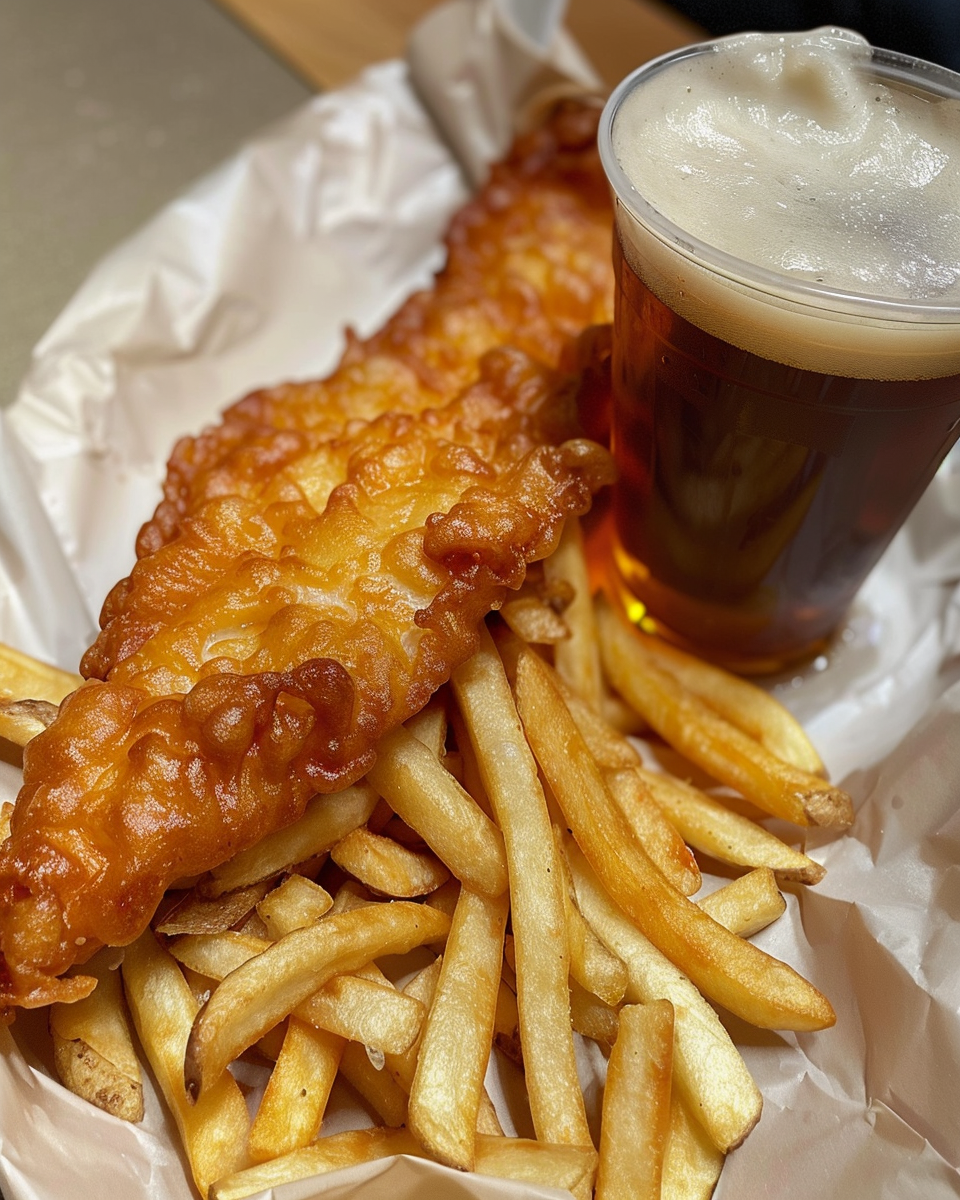Introduction
Hook:
Few dishes evoke the spirit of British comfort food as much as “fish and chips.” The golden, crispy batter surrounding flaky, tender fish, paired with perfectly cooked chips, has cemented its place as a classic. But what happens when you add a modern twist to this beloved dish? Enter golden ale-battered fish, where the light, effervescent bubbles of ale create a unique, extra-crispy crust, elevating the traditional to something truly special.
Brief History of Fish and Chips:
The origins of fish and chips date back to 19th-century Britain, when it became a popular staple among the working class. Fried fish, introduced by Jewish immigrants from Portugal and Spain, was paired with fried potatoes, giving birth to a dish that quickly became ingrained in British culture. From bustling city streets to quiet seaside towns, fish and chips became a symbol of British cuisine. Over time, the dish has evolved, with modern variations such as ale-battered fish, which brings a flavorful new dimension to the classic.
Why Golden Ale-Battered Fish and Chips?
The key difference between traditional batter and ale batter is in the ale itself. When added to the mix, golden ale lends both carbonation and flavor. The bubbles in the beer expand during frying, creating a lighter, airier batter, while the ale’s rich, malty notes add complexity. The contrast between the crispy exterior and the flaky, tender fish inside is irresistible, making this version a favorite for food lovers worldwide.
Modern Appeal:
Ale-battered fish is now a popular option at pubs and upscale restaurants alike, combining the depth and richness of craft beer with the simple pleasure of fried food. The golden ale enhances the dish’s flavor profile, appealing to those who appreciate both tradition and innovation. Whether you’re dining casually or preparing a gourmet meal, golden ale-battered fish and chips deliver on flavor, texture, and presentation.
Ingredients
Overview:
Before diving into the recipe, it’s essential to choose quality ingredients. Freshness is key to making this dish shine. Below is a detailed breakdown of the ingredients needed to create the perfect golden ale-battered fish and crispy chips.
For the Fish:
- Choice of Fish:
The best types of fish for frying are cod, haddock, and pollock, all of which have mild flavors and firm, flaky textures. These types of fish hold up well during frying, ensuring that the batter clings to the fillet and cooks evenly. - Preparation of Fish:
Properly preparing the fish is crucial. Begin by patting the fillets dry with paper towels to remove excess moisture, which can cause the batter to become soggy. Season both sides with salt and pepper to enhance the flavor before dipping in the batter.
For the Batter:
- Golden Ale:
The star ingredient of the batter is golden ale, known for its light carbonation and malty sweetness. The bubbles in the beer create an airy, crispy coating when fried, while the flavor of the ale adds depth. Choose a craft golden ale or a pale ale with a mild flavor for the best results. - Flour:
Use all-purpose or self-raising flour for the batter. Self-raising flour adds extra lift to the batter, while all-purpose flour provides a more neutral base. - Cornstarch (Optional):
Adding a small amount of cornstarch to the batter helps enhance its crispiness by creating a thinner, more brittle coating. - Baking Powder:
Baking powder further lightens the batter by adding air pockets, giving it a puffy, crispy texture. - Seasoning:
Salt and pepper are essential, but you can also add garlic powder, paprika, or a pinch of cayenne to the batter for extra flavor complexity.
For the Chips:
- Potato Choice:
Russet or Maris Piper potatoes are ideal for chips because they are starchy, ensuring a crispy exterior and fluffy interior. - Cooking Oil:
High smoke point oils such as vegetable oil, canola oil, or sunflower oil are best for frying, as they can withstand the high temperatures needed to achieve the perfect golden-brown color. - Seasoning:
After frying, season the chips with salt immediately. You can also drizzle malt vinegar over the top for a traditional British touch.
Instructions (Step-by-Step)
Step 1: Preparing the Fish
- Pat the fish fillets dry with paper towels to remove moisture, which ensures crispiness.
- Season both sides of the fish with salt and pepper to taste, ensuring an even distribution of seasoning.
Step 2: Making the Batter
- Mixing the Dry Ingredients:
In a large bowl, combine flour, cornstarch (optional), baking powder, and any seasonings you’re using (salt, pepper, garlic powder, paprika, etc.). - Incorporating the Ale:
Gradually pour the golden ale into the dry ingredients, whisking continuously to avoid lumps. The batter should be thick but pourable. - Chill the Batter:
Place the batter in the refrigerator for 10–15 minutes to let the ingredients combine and improve texture. Chilled batter sticks to the fish better, ensuring an even coat.
Step 3: Preparing the Chips
- Cutting the Potatoes:
Slice the potatoes into thick, uniform pieces for even cooking. - Blanching the Chips:
Parboil the sliced potatoes in boiling water for 5–6 minutes to soften them slightly. Drain them well and pat them dry thoroughly. - First Fry:
Heat the oil to 320°F (160°C) and fry the chips for 5–7 minutes, cooking them through without browning. Remove and set aside on paper towels.
Step 4: Frying the Fish
- Heating the Oil:
Increase the oil temperature to 350°F (175°C). - Coating the Fish:
Dip each fish fillet into the batter, making sure it’s completely coated. - Frying:
Carefully place the battered fillets into the hot oil and fry for 4–6 minutes, flipping halfway through to ensure even browning. When the fish is golden and crispy, transfer it to a wire rack or paper towels to drain excess oil.
Step 5: Final Fry of the Chips
- Second Fry:
Increase the oil temperature to 375°F (190°C). Fry the chips for 2–3 more minutes, until they turn golden and crispy. - Seasoning:
Remove the chips from the oil and season with salt immediately.
Step 6: Serving
Serve the crispy fish alongside the freshly fried chips. For an added burst of flavor, consider a wedge of lemon, tartar sauce, or a drizzle of vinegar.
Serving Suggestions
Presentation:
For an authentic British pub experience, serve the fish and chips on a newspaper-lined tray or plate. Garnish with fresh parsley and a lemon wedge for added color and a pop of citrus.
Side Dishes:
- Tartar Sauce: A classic, creamy condiment made with mayonnaise, pickles, capers, and lemon juice.
- Mushy Peas: A traditional British side dish made from crushed peas, butter, and mint.
- Coleslaw: Adds a crunchy contrast to the richness of the fried fish.
- Pickled Onions or Gherkins: These tangy accompaniments cut through the richness of the fried food.
Beverage Pairings:
- Beer Pairing: Serve with the same golden ale used in the batter for a seamless flavor experience. Pale lagers or IPAs also complement the crispiness of the fish and chips.
- Wine Pairing: A crisp, acidic white wine like Sauvignon Blanc or sparkling wine adds a refreshing contrast.
- Non-Alcoholic Options: A cold ginger beer or sparkling water with lemon provides a non-alcoholic but equally refreshing pairing.
Conclusion
Recap of the Recipe:
Golden ale-battered fish and crispy chips combine the best of traditional British cuisine with a modern twist. The delicate balance of flavors and textures—crispy batter, tender fish, and perfectly fried chips—makes this dish a must-try for any fish and chips lover.
Why You Should Try This Recipe:
This recipe is surprisingly easy to recreate at home, making it perfect for family dinners or special occasions. The versatility of the ingredients means you can experiment with different types of fish, seasonings, and sides.
Final Thoughts:
Encourage readers to get creative with their fish and chips by trying new fish varieties, making homemade sauces, or adding different sides. This classic pub dish can be tailored to your tastes and enjoyed in various settings, whether as casual comfort food or an upscale dining experience.
FAQs
- What is the best fish for frying?
Cod, haddock, and pollock are ideal for their mild flavors and firm, flaky textures. - Can I use non-alcoholic beer in the batter?
Yes, non-alcoholic beer or soda water works as a substitute to achieve a similarly crispy texture. - How do I make the batter extra crispy?
Cold batter, hot oil, and the addition of cornstarch help create a lighter, crispier batter. - Why do you fry the chips twice?
The first fry cooks the interior, while the second fry crisps the exterior. - Can I bake the fish and chips instead of frying?
Yes, but baking results in a less crispy texture. Coat the fish in panko breadcrumbs for added crunch. - How do I store leftovers?
Store leftovers in an airtight container in the fridge for up to two days and reheat in the oven for crispiness. - What’s the best oil for frying fish and chips?
Vegetable oil, canola oil, or sunflower oil work well due to their high smoke points. - Can I make the batter in advance?
Yes, you can make it a few hours ahead and refrigerate it. Cold batter results in a crisper texture during frying.

